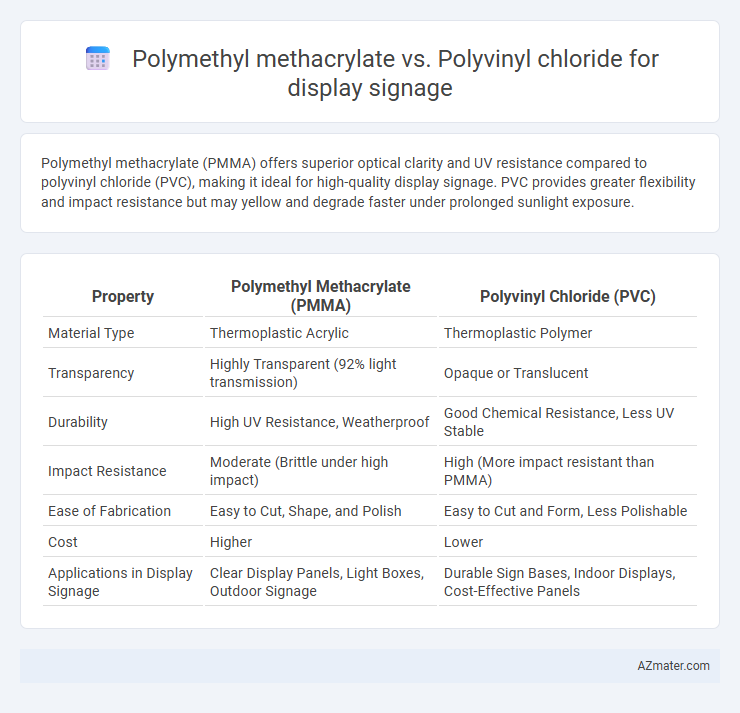Polymethyl methacrylate (PMMA) offers superior optical clarity and UV resistance compared to polyvinyl chloride (PVC), making it ideal for high-quality display signage. PVC provides greater flexibility and impact resistance but may yellow and degrade faster under prolonged sunlight exposure.
Table of Comparison
| Property | Polymethyl Methacrylate (PMMA) | Polyvinyl Chloride (PVC) |
|---|---|---|
| Material Type | Thermoplastic Acrylic | Thermoplastic Polymer |
| Transparency | Highly Transparent (92% light transmission) | Opaque or Translucent |
| Durability | High UV Resistance, Weatherproof | Good Chemical Resistance, Less UV Stable |
| Impact Resistance | Moderate (Brittle under high impact) | High (More impact resistant than PMMA) |
| Ease of Fabrication | Easy to Cut, Shape, and Polish | Easy to Cut and Form, Less Polishable |
| Cost | Higher | Lower |
| Applications in Display Signage | Clear Display Panels, Light Boxes, Outdoor Signage | Durable Sign Bases, Indoor Displays, Cost-Effective Panels |
Introduction to Display Signage Materials
Polymethyl methacrylate (PMMA) and Polyvinyl chloride (PVC) are commonly used materials in display signage due to their distinct physical properties and visual appeal. PMMA offers superior clarity, UV resistance, and weather durability, making it ideal for high-quality, outdoor signage that requires crisp and vibrant displays. PVC is favored for its cost-effectiveness, flexibility, and ease of fabrication, suitable for indoor signage where durability and budget constraints are critical.
Overview of Polymethyl Methacrylate (PMMA)
Polymethyl methacrylate (PMMA) is a transparent thermoplastic often used as a lightweight, shatter-resistant alternative to glass in display signage. Its high optical clarity, UV resistance, and excellent weatherability make it ideal for both indoor and outdoor applications, maintaining color vibrancy and structural integrity over time. PMMA's ease of fabrication, superior light transmission (up to 92%), and resistance to yellowing distinguish it from polyvinyl chloride (PVC), positioning it as a premium choice for high-quality visual displays.
Overview of Polyvinyl Chloride (PVC)
Polyvinyl chloride (PVC) is a widely used thermoplastic polymer in display signage due to its excellent durability, chemical resistance, and cost-effectiveness. It offers high rigidity and weather resistance, making it suitable for both indoor and outdoor applications, with strong impact resistance compared to other materials. PVC's versatility allows for easy fabrication, printing, and finishing, making it a practical choice for long-lasting, vibrant display signage solutions.
Durability Comparison: PMMA vs PVC
Polymethyl methacrylate (PMMA) offers superior UV resistance and weathering durability compared to polyvinyl chloride (PVC), making it ideal for long-term outdoor display signage. PMMA maintains clarity and structural integrity without yellowing or becoming brittle, whereas PVC tends to degrade faster under prolonged sun exposure and fluctuating temperatures. Physical impact resistance of PMMA is moderate, but overall, its longevity and resistance to environmental stress outperform PVC for durable signage applications.
Optical Clarity and Visual Appeal
Polymethyl methacrylate (PMMA) offers superior optical clarity compared to polyvinyl chloride (PVC), with light transmittance of approximately 92%, making it ideal for vibrant, high-visibility display signage. PMMA also provides excellent UV resistance and color retention, ensuring long-lasting visual appeal without yellowing over time. In contrast, PVC has lower clarity, typically around 80%, and can degrade under prolonged UV exposure, resulting in diminished aesthetic performance and shorter lifespan in outdoor signage applications.
Weather Resistance and UV Stability
Polymethyl methacrylate (PMMA) offers superior weather resistance and UV stability compared to Polyvinyl chloride (PVC), maintaining clarity and structural integrity under prolonged sun exposure and harsh environmental conditions. PMMA resists yellowing and surface degradation, making it ideal for outdoor display signage requiring long-term visual appeal. PVC, while cost-effective, tends to degrade faster when exposed to UV rays and varying weather, leading to discoloration and brittleness over time.
Cost-Effectiveness and Availability
Polymethyl methacrylate (PMMA) offers superior clarity and weather resistance for display signage but generally comes at a higher cost compared to polyvinyl chloride (PVC), which is more affordable and widely available. PVC's cost-effectiveness and easier fabrication make it a preferred choice for budget-conscious projects, although it may lack the optical quality and UV resistance found in PMMA. Availability of PVC is extensive in global markets, supporting its use in large-scale signage applications, while PMMA is favored in premium or outdoor displays where durability and visual appeal justify the investment.
Ease of Fabrication and Installation
Polymethyl methacrylate (PMMA) offers superior ease of fabrication for display signage due to its excellent machinability, ability to be laser cut, thermoformed, and polished to a high-gloss finish, enabling intricate and customized designs without cracking. Polyvinyl chloride (PVC) is also easy to fabricate but can be prone to melting or warping under high heat during cutting or bending, requiring more cautious handling and specific tools. In terms of installation, PMMA's lightweight and rigidity facilitate quicker mounting, whereas PVC's flexibility provides greater durability but may require additional support structures to maintain shape and stability over time.
Environmental Impact and Recyclability
Polymethyl methacrylate (PMMA) offers superior recyclability compared to polyvinyl chloride (PVC), as PMMA can be mechanically recycled without significant degradation of optical clarity, making it ideal for sustainable display signage. PVC production and disposal pose environmental challenges due to the release of harmful dioxins and the difficulty in separating additives, which limits its recycling potential and increases ecological risks. Choosing PMMA for display signage reduces environmental impact by facilitating circular material use and minimizing toxic emissions throughout the lifecycle.
Choosing the Best Material for Display Signage
Polymethyl methacrylate (PMMA) offers superior clarity, UV resistance, and weather durability, making it ideal for long-lasting, high-quality display signage in outdoor environments. Polyvinyl chloride (PVC) provides enhanced flexibility, affordability, and impact resistance, suitable for indoor signage and budget-friendly projects. Selecting the best material depends on specific signage requirements like exposure conditions, aesthetic needs, and cost constraints, with PMMA preferred for premium visibility and PVC for versatile, economical solutions.

Infographic: Polymethyl methacrylate vs Polyvinyl chloride for Display Signage
 azmater.com
azmater.com